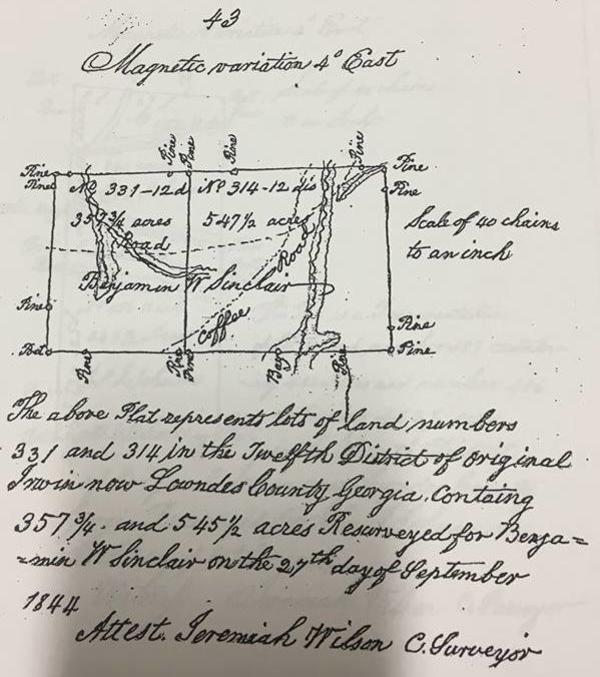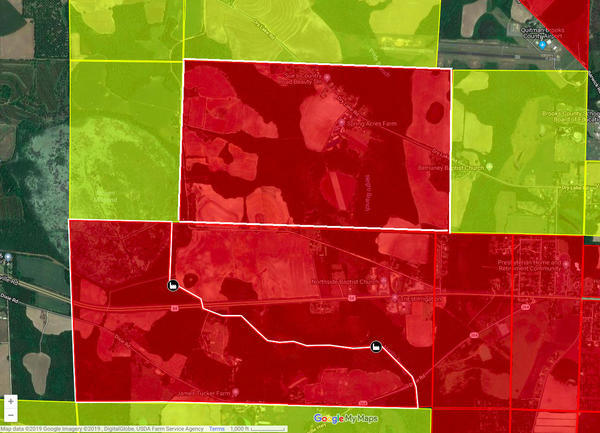Sky wanted to know how we’re fixing the mouse-gnawed hot water PEX hose.
![[Sky wants to know why that red hose is cut]](http://www.okraparadisefarms.com/pictures/2024-11-08--hot-water-line/20241108_075820.jpg)
Sky wants to know why that red hose is cut
Here’s a better look at the problem. Continue reading
Sky wanted to know how we’re fixing the mouse-gnawed hot water PEX hose.
![[Sky wants to know why that red hose is cut]](http://www.okraparadisefarms.com/pictures/2024-11-08--hot-water-line/20241108_075820.jpg)
Sky wants to know why that red hose is cut
Here’s a better look at the problem. Continue reading
Some old roads from a century ago are still in the woods in north central Lowndes County.
On this 1917 soil map of Lowndes County, Hambrick Road runs east from Hagan Bridge to Cat Creek Road, as it still does today. In the center of the map, running south from Hambrick Road, is an old road that I keep open in my woods. The other day we used a bit of it for a firebreak in a prescribed burn.
![[1917--hambrick-road-loco-soil-map]](http://www.okraparadisefarms.com/pictures/1917--lowndes-co-ga-soil-map/1917--hambrick-road-loco-soil-map.jpg)
Soil Map, Georgia, Lowndes County Sheet, Record ID cmf0373, U. S. Department of Agriculture, 1917, in
County Maps, Surveyor General, RG 3-9-66, Georgia Archives.
The house marked just north across Hambrick Road from that old road is still there. That was probably Fisher Gaskins’ house. I will ask his descendants.
That old woods road is between two creeks that are still there: Redeye Creek to its west, and Toms Branch to its right. They both end up in the Withlacoochee River floodplain.
Toms Branch is just east of the east part of Quarterman Road. Most of the rest of that road was already there in some form or other, although the south part of it, that currently runs straight east and west, did not run like that.
And notice all the other roads that are no longer open to the public. Continue reading
Turns out dogs like water.
![[Arrow, Honeybun, Blondie, at water spigot 2023-06-18]](http://www.okraparadisefarms.com/pictures/2023-06-18--dogs-water/many.jpg)
Arrow, Honeybun, Blondie, at water spigot 2023-06-18
Especially Arrow.
Here is a YouTube video playlist:
https://youtube.com/playlist?list=PLLk2OxkA4UvwDyXxn-2JbD8yV5vrShmCK
Facebook video version:
https://www.facebook.com/OkraParadiseFarms/posts/pfbid0LsEEoXSKQfFEztWjQcorn3g7d1nUPhGgiHmYBifQZhXmRMdQ52SNX5jzkEhVXHg5l
And some still pictures. Continue reading
Yellow Dog in the white corn as it tassles.
Yellow Dog would follow me every morning as I hoed the corn. Continue reading
“B W Sinclair also owned at one point some land along the Coffee Road,” says Wiregrass Region Digital History Project (WRDHP):

WRDHP photograph, apparently from Lowndes County records
43
Magnetic variation 4° East Continue reading
Update 2019-02-10: His previous land on Coffee Road at Jackson Road, and family pictures.
Much to my surprise, according to evidence turned up by the
Wiregrass Region Digital History Project (WRDHP),
an owner of the mill at Bowen Mill Pond west of Quitman, Georgia
was my great-great-grandfather, Benjamin Waters Sinclair.
In an
WRDHP facebook post 2019-02-06:
We have created a series of maps overlaid upon a modern google earth
map that depict Continue reading 
Annotated detail from
WRDHP Google map of old Irwin County ca. 1870.
 You can
register today for South Georgia Growing Local 2016,
to be held all day Saturday February 6th at Pine Grove Middle School.
Chris Beckham was struck by the variety: corn, chicken, fruits, goats, soap, composting, water, worms, solar power!
So many different topics in six tracks, “but all indigenous to South Georgia.”
You can
register today for South Georgia Growing Local 2016,
to be held all day Saturday February 6th at Pine Grove Middle School.
Chris Beckham was struck by the variety: corn, chicken, fruits, goats, soap, composting, water, worms, solar power!
So many different topics in six tracks, “but all indigenous to South Georgia.”
Gretchen replied,
Indeed, when this conference started six years ago, we just had two tracks. One was about cooking, and one was about growing, pest control, and fertilizing, and how to have your garden be successful in the special conditions of south Georgia and north Florida. Because our conditions here are different than they are in north Georgia or on the coast, or farther south in Florida where it never freezes. We sort of have a very special environment here, and so this conference is geared towards that.
Lots of new and repeat talks; see the Continue reading
How to Lower Your Water Bill by Collecting Rain Water is the topic of Marilyn Dye’s presentation at South Georgia Growing Local 2014:
My presentation will include information on the limited water supply available globally, the amount of water used by households on a daily basis, and how we can decrease the amount of tap water we through water conservation and by collecting rainwater.
Her conference bio: Continue reading
14 year old Rachel Parent destroys a pro-Monsanto-GMO TV host
 on every point, from science to his ad hominem attacks against her.
He twists, he turns, he avoids admitting when he’s defeated, and he loses
bigtime.
No summary can do this justice.
on every point, from science to his ad hominem attacks against her.
He twists, he turns, he avoids admitting when he’s defeated, and he loses
bigtime.
No summary can do this justice.
Mat Agorist posted for Realfarmacy.com 30 August 2013 about the CNBC Lang & O’Leary show of 31 July 2013, 14 Year Old, Rachel Parent, Anti-GMO Activist, Destroys Establishment Shill, Kevin O’Leary, On Air
Meet Rachel Parent, a 14 year old activist, who knows her stuff! This brave girl should serve as a role model for all teens. If 10 percent of children had this girl’s drive and knowledge, we wouldn’t even be having this debate right now.
In this video Ms. Parent braves the establishment hack, Kevin O’Leary, and does outstanding. O’Leary hammers out the industry talking points like the good shill he is and Ms. Parent slams each and every one. Bravo Rachel Parent, thanks for doing what you do.
If you like the work of Rachel Parent and want to help, please visit her website at http://www.gmo-news.com.
Here’s the video:
Continue reading